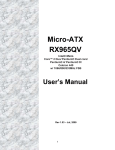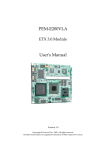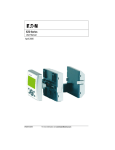Download WADE-8071 User`s Manual
Transcript
WADE-8071
Mini-ITX Board
User's Manual
Version 1.0
Copyright © Portwell, Inc., 2009. All rights reserved.
All other brand names are registered trademarks of their respective owners.
Preface
Table of Contents
How to Use This Manual
Chapter 1 System Overview.......................................................................................................1-1
1.1 Introduction.................................................................................................................................. 1-1
1.2 Check List ..................................................................................................................................... 1-1
1.3 Product Specification .................................................................................................................. 1-2
1.3.1 Mechanical Drawing......................................................................................................... 1-5
1.4 System Architecture .................................................................................................................... 1-7
Chapter 2 Hardware Configuration ...........................................................................................2-1
2.1 Jumper Setting ............................................................................................................................. 2-1
2.2 Connector Allocation .................................................................................................................. 2-3
Chapter 3 System Installation....................................................................................................3-1
3.1 Intel® ATOM CPU ...................................................................................................................... 3-1
3.2 Main Memory .............................................................................................................................. 3-1
3.3 Installing the Single Board Computer ...................................................................................... 3-2
3.3.2 Chipset Component Driver.............................................................................................. 3-2
3.3.3 Intel Integrated Graphics GMCH Chip .......................................................................... 3-2
3.3.4 Realtek Gigabit Ethernet Controller ............................................................................... 3-3
3.3.5 Audio Controller ............................................................................................................... 3-3
3.4 Clear CMOS Operation............................................................................................................... 3-3
3.5 WDT Function.............................................................................................................................. 3-4
3.6 GPIO .............................................................................................................................................. 3-5
3.6.1 Pin assignment................................................................................................................... 3-5
3.6.2 WADE-8071 GPIO Programming Guide ....................................................................... 3-6
3.6.3 Example .............................................................................................................................. 3-7
Chapter 4 BIOS Setup Information............................................................................................4-1
4.1 Entering Setup.............................................................................................................................. 4-1
4.2 Main Menu ................................................................................................................................... 4-2
4.3 Standard CMOS Setup Menu .................................................................................................... 4-3
4.4 IDE Adaptors Setup Menu......................................................................................................... 4-4
4.5 Advanced BIOS Features............................................................................................................ 4-6
4.6 Advanced Chipset Features ..................................................................................................... 4-10
4.7 Integrated Peripherals .............................................................................................................. 4-12
4.8 Power Management Setup ....................................................................................................... 4-17
4.9 PnP/PCI Configurations .......................................................................................................... 4-20
4.10 PC Health Status...................................................................................................................... 4-21
4.11 Default Menu ........................................................................................................................... 4-22
4.12 Supervisor/User Password Setting ...................................................................................... 4-22
4.13 Exiting Selection ...................................................................................................................... 4-23
Chapter 5 Troubleshooting ........................................................................................................5-1
5.1 Hardware Quick Installation ..................................................................................................... 5-1
5.2 BIOS Setting.................................................................................................................................. 5-2
5.3 Ordering Setting .......................................................................................................................... 5-3
5.4 FAQ ............................................................................................................................................... 5-4
Appendix A
Appendix B
Preface
How to Use This Manual
The manual describes how to configure your system board to meet various operating
requirements. It is divided into five chapters, with each chapter addressing a basic
concept and operation of Single Host Board.
Chapter 1 : System Overview. Presents what you have in the box and give you an
overview of the product specifications and basic system architecture for this series
model of single host board.
Chapter 2 : Hardware Configuration. Shows the definitions and locations of Jumpers
and Connectors that you can easily configure your system.
Chapter 3 : System Installation. Describes how to properly mount the CPU, main
memory and Compact Flash to get a safe installation and provides a programming
guide of Watch Dog Timer function.
Chapter 4 : BIOS Setup Information. Specifies the meaning of each setup
parameters, how to get advanced BIOS performance and update new BIOS. In
addition, POST checkpoint list will give users some guidelines of trouble-shooting.
Chapter 5 : Troubleshooting. Provides various useful tips to quickly get its running
with success. As basic hardware installation has been addressed in Chapter 3, this
chapter will basically focus on system integration issues, in terms of backplane setup,
BIOS setting, and OS diagnostics.
The content of this manual is subject to change without prior notice. These changes
will be incorporated in new editions of the document. Portwell may make
supplement or change in the products described in this document at any time.
Updates to this manual, technical clarification, and answers to frequently asked
questions will be shown on the following web site : http://www.portwell.com.tw/
System Overview
Chapter 1
System Overview
1.1
Introduction
Portwell Inc., a world-leading innovator in the Industrial PC (IPC) market and
develop a new Intel® Mini-ITX board with latest Intel® platform for embedded
application. The Portwell WADE-8071 takes advantage of Intel® 45-nanometer Hi-k
process technology — the first generation of low-power IA-32 microarchitecture
specially designed for Embedded Platform and can support Intel® 945GSE chipset
with the ICH7-M, can provide the low power consumption for low profile fanless
applications such as POS, ATM, Kiosk, Medical, Panel PC and Digital Signage.
WADE-8071 supports dual display by VGA and 24-bit LVDS. With its
display-enriched interface, WADE-8071 can support various multimedia devices
and enriched IO interfaces that can supply various USB and COM devices.
WADE-8071 supports SO-DIMM memory slot for DDR2 SDRAM up to 2GB, and
comes with PS/2 Keyboard and Mouse header, 2 x RS232, 2 x SATA, 1 x IDE, 1 x
Gigabit Ethernet, 6 x USB2.0 ports. It also support CompactFlash Socket and one
PCIEx1 Slot for embedded application usage.
1.2
Check List
The WADE-8071 package should cover the following basic items
One WADE-8071 Mini ITX Main Board
One Serial ATA Cable
One SATA Power Cable
One I/O Shield bracket
One Installation Resources CD-Title
If any of these items is damaged or missing, please contact your vendor and keep all
packing materials for future replacement and maintenance.
WADE-8071 User’s Manual
1-1
System Overview
1.3
Product Specification
Main processor
- Support Intel Atom processor N270
- CPU bus clock: 667/533 MHz
Chipset
Intel® 945GSE and ICH7-M
Main Memory
- Support signal channel DDR2 memory interface
- Up to 2GB DDR2 533 SDRAM on SO-DIMM socket
System BIOS
AWARD BIOS
Expansion Interface
One PCI Express x1 slot
SATA Interface
Two SATA ports
Serial Ports
Support two RS-232 serial ports
IR Interface
N/A
Parallel Port
N/A
USB Interface
Support six USB (Universal Serial Bus) ports (four at rear, two on-board for
internal devices)
PS/2 Mouse and Keyboard Interface
Support on board pin header for PS/2 keyboard/mouse
Audio Interface
Connector of Mic-in/Line-out
Real Time Clock/Calendar (RTC)
Support Y2K Real Time Clock/Calendar
Watchdog Timer
- Support WDT function through software programming for enable/disable and
interval setting
- Generate system reset
On-board VGA
- Intel 945GSE Integrated GMA950 Graphics device
- Intel DVMT 3.0 supports up to 128MB video memory
WADE-8071 User’s Manual
1-2
System Overview
On-board Ethernet LAN
One Gigabit Ethernet (10/100/ 1000 Mbits/sec) LAN ports
High Driving GPIO
Onboard programmable 8-bit Digital I/O interface
Cooling Fans
Support one 3-pin power connector for system fan
System Monitoring Feature
Monitor system temperature and major power sources, etc
Outline Dimension (L X W):
170mm (6.69”) X 170mm (6.69”)
Power Requirements:
+12V(Board)@1.25A
Configuration:
System Configuration
CPU Type
SBC BIOS
Memory
Intel® Atom™ N270 1.60GHz (133*12) L2:512K FSB:533MHz
Portwell, Inc. WADE-8071 BIOS Rev.: R1.00.W0.T0 (02192009)
Transcend DDR2 533MHz 2GB (Micron 7WE17 D9HNL)
VGA Card
VGA Driver
LAN Card
LAN Driver
Onboard Mobile Intel® 845 Express Chipset Family
Mobile Intel® 845 Express Chipset Family Version 6.14.10.4926
Onboard Realtek RTL8111C PCI-E Gigabit Ethernet NIC
Realtek RTL8168C/8111C(P) PCI-E Gigabit Ethernet
Version 5.698.701.2008
Onboard Realtek ALC662 Audio Chipset
Realtek High Definition Audio Version 5.10.0.5735
Intel® Chipset Device Software Version 8.3.0.1013
Intel® 8201G (ICH7 Family) USB2 Enhanced Host Controller
Version 8.2.0.1008
Seagate ST3120813AS 120GB
Apacer 64MB
LITE-ON LH20A1S DVD-ROM
Portwell,Inc PW-330ATXE-12V
Audio Card
Audio Driver
Chip Driver
USB 2.0 Driver
SATA HDD
Compact Flash
CDROM
Power Supply
WADE-8071 User’s Manual
1-3
System Overview
Programs for loading both CPU & VGA: Run Burning Test V5.3
RUN time: 10 / 30 Minutes.
Item
Power ON
Full Loading
10Min
Full Loading
30Min
System +12V
1.25A
1.80A
1.85A
USB Loading Test
5.2 V/ 0.6 A
N/A
N/A
Operating Temperature:
0°C ~ 55°C
Storage Temperature:
-20°C ~ 80°C
Relative Humidity:
5% ~ 90%, non-condensing
WADE-8071 User’s Manual
1-4
System Overview
1.3.1
Mechanical Drawing
[TOP side]
WADE-8071 User’s Manual
1-5
System Overview
[Bottom side]
WADE-8071 User’s Manual
1-6
System Overview
1.4
System Architecture
All of details operating relations are shown in WADE-8071 series System Block
Diagram
WADE-8071 System Block Diagram
WADE-8071 User’s Manual
1-7
Hardware Configuration
Chapter 2
Hardware Configuration
This chapter gives the definitions and shows the positions of jumpers, headers and
connector. All of the configuration jumpers on WADE-8071 are in the proper position.
The default settings are indicated with a star sign (Ì).
2.1
Jumper Setting
In general, jumpers on the single board computer are used to select options for certain
features. Some of the jumpers are designed to be user-configurable, allowing for
system enhancement. The others are for testing purpose only and should not be
altered. To select any option, cover the jumper cap over (SHORT) or remove (NC) it
from the jumper pins according to the following instructions. Here NC stands for
“Not Connect”.
11
J6
15
J7
J3
5
J1
J4
JP2
J2
J5
JP1
J8
JP3
J9
J10
JP15
A2
A1
B1
B2
JP4
JP5
BZ
J13
42
40
41 39
2
A17
A18
B17 B18
JP6
JP7
J11
8
JP8
17
16
48
49
64
SPI
199
J12
200
30
JP9
32
33
5
29
3
2
4
JP10
CPU
BAT
JP11
J14
J15
JP13
44
9
J16
43
JP14
JP12
J18
J17
Figure 2-1 WADE-8071 Top-side Jumper and Connector Locations
WADE-8071 User’s Manual
2-1
Hardware Configuration
JP9 : CMOS Clear
PIN1
JP9
1-2 Short
2-3 Short
Function
Normal Operation Ì
Clear CMOS Contents
JP6 : PANEL BACKLIGHT Selection
PIN1
2
5
6
Pin No.
1-3, 2-4
1-3, 4-6
3-5,2-4
3-5,4-6
Signal Description
5V, Active High Ì
12V, Active High
5V, Active Low
12V, Active Low
JP8 : PANEL Voltage Selection
PIN1
2
5
6
JP8
2-4 Short
4-6 Short
3-4 Short
Function
VCC3 Ì
VCC
+12V
JP8 : Pin Assignments
PIN No.
1
2
Signal
Description
N/A
VCC
PIN No.
3
4
Signal
Description
+12V
VDDVLDS_IN
PIN No.
5
6
Signal
Description
N/A
VCC3
Note:
Wrong voltage selection may damage the LVDS panel.
Please survey LVDS panel’s VDD before setup this jumper setting.
WADE-8071 User’s Manual
2-2
Hardware Configuration
2.2
Connector Allocation
I/O peripheral devices and Flash disk will be connected to these interface connectors.
Connector Function List
Connector
J1
J2
J3
J4/J5
J6
J7
J8
J9
J10
J11
J12
J13
J14/J15
J16
J17
J18
J19
JP1
JP2
JP3
JP4
JP5
JP7
JP11
JP12/JP14
JP13
Description
VGA Connector
COM Port Connector
POWER DC Jack
USB Connector
MIC Audio Jack
Line_out Audio Jack
RJ45 LAN Connector
POWER DC +12V Connector
CASEOPEN Pin HDR
SO-DIMM DDRII Socket
LVDS Connector
PCIE x1 SLOT
SATA Connector
IDE Connector
System FAN
CPU FAN
CF Socket
COM Port Pin HDR
MIC Pin HDR
Line_out Pin HDR
KB/MS Pin HDR
GPIO Pin HDR
Front Panel Pin HDR
BACK LIGHT PWR Connector
External +5V/+12V Pin HDR
External USB Pin HDR
WADE-8071 User’s Manual
Remark
D-Sub15
D-Sub9
Dual USB/TypeA
Wafer 2mm
DF13-30DP
22P*2
5P*2
Wafer 2mm
Wafer 2mm
5P*2
Wafer 2mm
Wafer 2mm
2-3
Hardware Configuration
Pin Assignments of Connectors
J9 : POWER DC +12V Connector
3
2
4
PIN No.
1
2
3
4
Signal Description
Ground
Ground
+12V
+12V
J10 : CASEOPEN PIN HDR
PIN1
2
PIN No.
1
2
Signal Description
CASEOPEN Signal
Ground
J12 : LVDS Connector
2
PIN1
PIN No.
1
3
5
7
9
11
13
15
17
19
21
Signal Description
LCD1DO0+
LCD1DO1+
LCD1DO2+
LCD1DO3+
LCD1CLK+
LCD2DO0+
LCD2DO1+
LCD2DO2+
LCD2DO3+
LCD2CLK+
LCLK1
WADE-8071 User’s Manual
PIN No.
2
4
6
8
10
12
14
16
18
20
22
Signal Description
LCD1DO0LCD1DO1LCD1DO2LCD1DO3LCD1CLKLCD2DO0LCD2DO1LCD2DO2LCD2DO3LCD2CLKLDATA1
2-4
Hardware Configuration
23
25
27
29
GND
GND
POWER
N/C
24
26
28
30
N/C
Ground
POWER
POWER
JP1 : COM Serial Port
PIN1
2
PIN No.
1
2
3
4
5
6
7
8
9
10
Signal Description
DCD
DSR
RXD
RTS
TXD
CTS
DTR
RI
Ground
Ground
JP2 : MIC Pin HDR
PIN1
PIN No.
1
2
3
4
Signal Description
MIC_L
Ground
MIC_R
Ground
JP3 : LINE_OUT Pin HDR
PIN1
PIN No.
1
2
3
4
Signal Description
LINE_OUT_L
Ground
LINE_OUT_R
Ground
WADE-8071 User’s Manual
2-5
Hardware Configuration
JP4 : External PS/2 Keyboard/Mouse Pin HDR
PIN1
2
PIN No.
1
5
7
9
Signal Description
Mouse Data
Key ( no pin )
Ground
Power
Mouse CLK
PIN No.
2
6
8
10
Signal Description
Keyboard Data
Key ( no pin )
Ground
Power
Keyboard CLK
PIN No.
2
4
6
8
10
Signal Description
GPIO4
GPIO5
GPIO6
GPIO7
+5V
JP5 : GPIO Pin HDR
PIN1
2
PIN No.
1
3
5
7
9
Signal Description
GPIO0
GPIO1
GPIO2
GPIO3
Ground
Note:
All General Purpose I/O ports can only apply to standard TTL ± 5% signal level
(0V/5V), and each Fan.
WADE-8071 User’s Manual
2-6
Hardware Configuration
JP7 : Front Panel Pin HDR
PIN1
2
PIN No.
1
3
5
7
9
11
13
15
Signal Description
5VSBY through 330 ohm
N/C
PWRLED
N/C
N/C
N/C
+5V through 150 ohm
HDD_LED#
PIN No.
2
4
6
8
10
12
14
16
Signal Description
N/C
N/C
N/C
N/C
5VSBY through 1k ohm
PWR_ON
RESET#
Ground
JP11 : BACL LIGHT PWR Pin HDR
PIN1
PIN No.
1
2
3
4
5
Signal Description
BACK LIGHT ENABLE
GND
+12V
GND
VCC
WADE-8071 User’s Manual
2-7
Hardware Configuration
JP12/JP14 : External +5V/+12V Pin HDR
4
PIN1
PIN No.
1
2
3
4
Signal Description
+12V
Ground
Ground
+5V
JP13 : External USB Pin HDR
PIN1
PIN No.
1
3
5
7
2
Signal Description
5V Dual
USBUSB+
Ground
Key( no pin )
WADE-8071 User’s Manual
PIN No.
2
4
6
8
10
Signal Description
5V Dual
USBUSB+
Ground
N/C
2-8
System Installation
Chapter 3
System Installation
This chapter provides you with instructions to set up your system. The additional
information is enclosed to help you set up onboard PCI device, handle Watch Dog
Timer (WDT) and operation of GPIO in software programming.
3.1
Intel® ATOM CPU
WADE-8071 onboard uses Intel Atom N270 CPU 1.6GHz processor.
Introducing Intel Atom processor, a new microprocessor designed from the ground
up for mobility, with a mobile-optimized chipset. Intel mobile processor innovative
design techniques allow faster execution of instructions at lower power.
3.2
Main Memory
WADE-8071 provides 1 x 200-pin SO-DIMM sockets which supports 667/533
DDR2-SDRAM as main memory, Non-ECC (Error Checking and Correcting),
non-register functions. The maximum memory size can be up to 2GB capacity.
Memory clock and related settings can be detected by BIOS via SPD interface.
For system compatibility and stability, do not use memory module without brand.
Memory configuration can be either one double-sided DIMM in either one DIMM
socket or two single-sided SO-DIMM in both sockets.
Watch out the contact and lock integrity of memory module with socket, it will
impact on the system reliability. Follow normal procedures to install memory module
into memory socket. Before locking, make sure that all modules have been fully
inserted into the card slots.
CPU FSB
533MHz
Memory Frequency
667MHz
533 MHz
Bandwidth
4.2GB/s
Single Channel DDR
Bandwidth
4.2GB/s
4.2GB/s
Note:
To maintain system stability, don’t change any of DRAM parameters in BIOS setup to
upgrade system performance without acquiring technical information.
WADE-8071 User’s Manual
3-1
System Installation
Memory frequency / CPU FSB synchronization
WADE-8071 supports different memory frequencies depending on the CPU front
side bus and the type of DDR2 SO-DIMM.
CPU FSB
533 MHz
3.3
Memory Frequency
667/533MHz
Installing the Single Board Computer
To install your WADE-8071 into standard chassis or proprietary environment, please
perform the following:
Step 1 : Check all jumpers setting on proper position
Step 2 : Install and configure CPU and memory module on right position
Step 3 : Place WADE-8071 into the dedicated position in the system
Step 4 : Attach cables to existing peripheral devices and secure it
WARNING
Please ensure that SBC is properly inserted and fixed by mechanism.
Note:
Please refer to section 3.3.1 to 3.3.7 to install INF/VGA/LAN/Audio drivers.
3.3.2
Chipset Component Driver
The chipset on WADE-8071 is a new chipset that a few old operating systems might
not be able to recognize. To overcome this compatibility issue, for Windows
Operating Systems such as Windows 2000 /XP, please install its INF before any of
other Drivers are installed. You can find very easily this chipset component driver in
WADE-8071 CD-title.
3.3.3
Intel Integrated Graphics GMCH Chip
Using Intel® 945GSE GMCH with Media Accelerator (GMA) 950 graphics integrated
chipset is aimed to gain an outstanding graphic performance. Shared 8 accompany it
to 128MB system DDR2-SDRAM with Total Graphics Memory. This combination
makes WADE-8071 an excellent piece of multimedia hardware.
With no additional video adaptor, this onboard video will usually be the system
display output. By adjusting the BIOS setting to disable on-board VGA, an add-on
PCI-Express by 1 VGA card can take over the system display.
WADE-8071 User’s Manual
3-2
System Installation
Drivers Support
Please find Springdale GMCH driver in the WADE-8071 CD-title. Drivers support
Windows-2000, Windows XP.
3.3.4
Realtek Gigabit Ethernet Controller
Drivers Support
Please find Realtek RTL8111C LAN driver in /Ethernet directory of WADE-8071
CD-title. The drivers support Windows 2000 /XP.
LED Indicator (for LAN status)
WADE-8071 provides two LED indicators to report Realtek RTL8111C Gigabit
Ethernet interface status. Please refer to the table below as a quick reference guide.
8111C
Color
Name of LED
Status
LED
Orange
LAN Linked & Active LED
Orange
Speed
LED
3.3.5
LAN speed LED
Green
Operation of Ethernet Port
Linked
Active
On
Blinking
Giga
Mbps
100
Mbps
10
Mbps
Orange
Green
Off
Audio Controller
Please find Realtek ALC662 Audio driver form WADE-8071 CD-title. The drivers
support Windows 2000 /XP.
3.4
Clear CMOS Operation
The following table indicates how to enable/disable Clear CMOS Function hardware
circuit by putting jumpers at proper position.
3
2
1
Normal
JP9
1-2 Short
2-3 Short
3
2
1
Clear
Function
Normal Operation Ì
Clear CMOS contents
WADE-8071 User’s Manual
3-3
System Installation
3.5
WDT Function
The working algorithm of the WDT function can be simply described as a counting
process. The Time-Out Interval can be set through software programming. The
availability of the time-out interval settings by software or hardware varies from
boards to boards.
WADE-8071 allows users control WDT through dynamic software programming. The
WDT starts counting when it is activated. It sends out a signal to system reset or to
non-maskable interrupt (NMI), when time-out interval ends. To prevent the time-out
interval from running out, a re-trigger signal will need to be sent before the counting
reaches its end. This action will restart the counting process. A well-written WDT
program should keep the counting process running under normal condition. WDT
should never generate a system reset or NMI signal unless the system runs into
troubles.
The related Control Registers of WDT are all included in the following sample
program that is written in C language. User can fill a non-zero value into the
Time-out Value Register to enable/refresh WDT. System will be reset after the
Time-out Value to be counted down to zero. Or user can directly fill a zero value into
Time-out Value Register to disable WDT immediately. To ensure a successful
accessing to the content of desired Control Register, the sequence of following
program codes should be step-by-step run again when each register is accessed.
Additionally, there are maximum 2 seconds of counting tolerance that should be
considered into user’ application program. For more information about WDT, please
refer to Winbond W83627HG-AW data sheet.
There are two PNP I/O port addresses that can be used to configure WDT,
1) 0x2E:EFIR (Extended Function Index Register, for identifying CR index number)
2) 0x2F:EFDR (Extended Function Data Register, for accessing desired CR)
Below are some example codes, which demonstrate the use of WDT.
//Step1. Enter W83627HG configuration registers mode:
outportb(0x2E, 0x87);
outportb(0x2E, 0x87);
//* Step2. Pin89 to be WDTO
outportb(0x2E, 0x2b);
outportb(0x2E + 1, 0x04);
//* Step3. Select logic device 8:
outportb(0x2E, 0x07);
outportb(0x2E + 1, 0x08);
WADE-8071 User’s Manual
3-4
System Installation
//* Step4. Config WDT using second to be unit:
outportb(0x2E, 0xf5);
outportb(0x2E + 1, 0x00);
//* Step5. Set WDT time-out time:
outportb(0x2E, 0xf6);
outportb(0x2E + 1, time_out);
//* Step6. Exit configuration registers mode:
outportb(0x2E, 0xaa);
3.6
GPIO
The WADE-8071 provides 8 programmable input or output ports that can be
individually configured to perform a simple basic I/O function. Users can configure
each individual port to become an input or output port by programming register bit
of I/O Selection. To invert port value, the setting of Inversion Register has to be
made. Port values can be set to read or write through Data Register.
3.6.1
Pin assignment
JP5 : General Purpose I/O Connector
PIN No.
1
2
3
4
5
6
7
8
9
10
Signal Description
General Purpose I/O Port 0 (GPIO0)
General Purpose I/O Port 4 (GPIO4)
General Purpose I/O Port 1 (GPIO1)
General Purpose I/O Port 5 (GPIO5)
General Purpose I/O Port 2 (GPIO2)
General Purpose I/O Port 6 (GPIO6)
General Purpose I/O Port 3 (GPIO3)
General Purpose I/O Port 7 (GPIO7)
Ground
+5V
All General Purpose I/O ports can only apply to standard TTL ± 5% signal level
(0V/5V), and each source sink capacity up to 12mA.
WADE-8071 User’s Manual
3-5
System Installation
3.6.2
WADE-8071 GPIO Programming Guide
There are 8 GPIO pins on WADE-8071. These GPIO pins are from SUPER I/O
(W83627GH-AW) GPIO pins, and can be programmed as Input or Output direction.
JP5 pin header is for 8 GPIO pins and its pin assignment as following :
JP5_Pin1=GPIO0:from SUPER I/O_GPIO10 with Ext. 4.7K PH
JP5_Pin2=GPIO4:from SUPER I/O_GPIO14 with Ext. 4.7K PH
JP5_Pin3=GPIO1:from SUPER I/O_GPIO11 with Ext. 4.7K PH
JP5_Pin4=GPIO5:from SUPER I/O_GPIO15 with Ext. 4.7K PH
JP5_Pin5=GPIO2:from SUPER I/O_GPIO12 with Ext. 4.7K PH
JP5_Pin6=GPIO6:from SUPER I/O_GPIO16 with Ext. 4.7K PH
JP5_Pin7=GPIO3:from SUPER I/O_GPIO13 with Ext. 4.7K PH
JP5_Pin8=GPIO7:from SUPER I/O_GPIO17 with Ext. 4.7K PH
<<<<< Be careful Pin9=GND , Pin10=VCC >>>>>
There are several Configuration Registers (CR) of W83627HG-AW needed to be
programmed to control the GPIO direction, and status(GPI)/value(GPO). CR00h ~
CR2F are common (global) registers to all Logical Devices (LD) in W83627HG. CR07h
contains the Logical Device Number that can be changed to access the LD as needed.
LD7 contains the GPIO10~17 registers.
Programming Guide:
Step1: CR2A_Bit [7.2]. P [1,1,1,1,1,1]; to select multiplexed pins as GPIO10~17 pins
Step2: LD7_CR07h.P [07h]; Point to LD7
Step3: LD7_CR30h_Bit0.P1; Enable LD7
Step4: Select GPIO direction, Get Status or output value.
LD7_CRF0h; GPIO17 ~ 10 direction, 1 = input, 0 = output pin
LD7_CRF2h.P [00h]; Let CRF1 (GPIO data port) non-invert to prevent from confusion
LD7_CRF1h; GPIO17~10 data port, for input pin, get status from the related bit, for
output pin, write value to the related bit.
For example,
LD7_CRF0h_Bit4.P0; Let GPIO14 as output pin
LD7_CRF2h_Bit4.P0; Let CRF1_Bit4 non-inverted
LD7_CRF1h_Bit4.P0; Output “0” to GPIO14 pin (J25_Pin6)
LD7_CRF0h_Bit0.P1; Let GPIO10 as input pin
LD7_CRF2h_Bit0.P0; Let CRF1_Bit0 non-inverted
Read LD7_CRF1h_Bit0; Read the status from GPIO10 pin (J25_Pin1)
WADE-8071 User’s Manual
3-6
System Installation
How to access W83627HG CR?
In WADE-8071, the EFER = 002Eh, and EFDR = 002Fh.
EFER and EFDR are 2 IO ports needed to access W83627HG-AW CR.
EFER is the Index Port, EFDR is the Data Port.
CR index number needs to be written into EFER first,
Then the data will be read/written from/to EFDR.
To R/W W83627HG-AW CR, it is needed to Enter/Enable Configuration Mode first.
When completing the programming, it is suggested to Exit/Disable Configuration
Mode.
Enter Configuration Mode: Write 87h to IO port EFER twice.
Exit Configuration Mode: Write AAh to IO port EFER.
3.6.3
Example
void enter_Superio2_CFG(void)
{
outportb(0x2E, 0x87);
outportb(0x2E, 0x87);
}
void exit_Superio2_CFG(void)
{
outportb(0x2E, 0xAA);
}
void Set_CFG2(unsigned char Addr2,unsigned char Value2)
{
unsigned char d2;
outportb(0x2E, Addr2);
delay(2);
outportb(0x2E +1, Value2);
delay(2);
}
unsigned char Get_CFG2(unsigned char Addr2)
{
unsigned char d2;
outportb(0x2E, Addr2);
delay(2);
d2 = inportb(0x2E +1);
delay(2);
return(d2);
}
WADE-8071 User’s Manual
3-7
System Installation
int main(void)
{
unsigned char d2;
enter_Superio2_CFG();
/* CR2A B7 = 1 selet GPIO Port 1*/
d2 = Get_CFG2(0x2A);
d2 = (d2 & 0x7F) | 0x80;
Set_CFG2(0x2A, d2);
/* IO test loop 1 */
/* Set GPIO Port 1 of Superio 2 Enable */
Set_CFG2(0x07, 0x07);
Set_CFG2(0x30, 0x01);
/* Select logic device 07 of Superio2*/
/* Enable GPIO Port 1 of Superio2*/
/* IO test loop 1 */
/* Set GPIO Port 1 of Superio2 Enable */
Set_CFG2(0x07, 0x07); /* Select logic device 07*/
Set_CFG2(0xF0, 0x0F);
/* GPIO Port 1 of Superio2 is [ooooiiii], o: output, i:input
*/
Set_CFG2(0xF2, 0x00);
/* GPIO Port 1 of Superio2 is non-inversed*/
Set_CFG2(0x07, 0x07);
Set_CFG2(0xF1, 0xFF);
/* Select logic device 07*/
/* Initial back all GPIO Port1 of Superio 2 to hi */
Set_CFG2(0x07, 0x07);
Set_CFG2(0xF1, 0xEF);
Set_CFG2(0x07, 0x07);
d2 = Get_CFG2(0xF1);
/* Select logic device 07*/
/* GP14 of Superio2 -> ~GP10 of Superio2 */
/* Select logic device 07 of Superio2*/
/* get GPIO Port 2 data */
if (d2 == 0xEE )
printf("\n GPIO14->10 test ok");
else
printf("\n GPIO14->10 test fail ");
WADE-8071 User’s Manual
3-8
BIOS Setup Information
Chapter 4
BIOS Setup Information
WADE-8071 is equipped with the AWARD BIOS stored in Flash ROM. These BIOS
has a built-in Setup program that allows users to modify the basic system
configuration easily. This type of information is stored in CMOS RAM so that it is
retained during power-off periods. When system is turned on, WADE-8071
communicates with peripheral devices and checks its hardware resources against the
configuration information stored in the CMOS memory. If any error is detected, or
the CMOS parameters need to be initially defined, the diagnostic program will
prompt the user to enter the SETUP program. Some errors are significant enough to
abort the start-up.
4.1
Entering Setup
Turn on or reboot the computer. When the message “Hit <DEL> if you want to run
SETUP” appears, press <Del> key immediately to enter BIOS setup program.
If the message disappears before you respond, but you still wish to enter Setup,
please restart the system to try “COLD START” again by turning it OFF and then
ON, or touch the "RESET" button. You may also restart from “WARM START” by
pressing <Ctrl>, <Alt>, and <Delete> keys simultaneously. If you do not press the
keys at the right time and the system will not boot, an error message will be displayed
and you will again be asked to,
Press <F1> to Run SETUP or Resume
In HIFLEX BIOS setup, you can use the keyboard to choose among options or modify
the system parameters to match the options with your system. The table below will
show you all of keystroke functions in BIOS setup.
↑↓→ ←
Enter
+ / - /PU /PD
ESC
F1
F2
F5
F6
F7
F9
F10
General Help
: Move
: Select
: Value
: Exit
: General Help
: Item Help
: Previous Values
: Fail-Safe Defaults
: Optimized Defaults
: Menu in BIOS
: Save
WADE-8071 User’s Manual
4-1
BIOS Setup Information
4.2
Main Menu
Once you enter WADE-8071 AWARD BIOS CMOS Setup Utility, a Main Menu is
presented. The Main Menu allows user to select from eleven setup functions and two
exit choices. Use arrow keys to switch among items and press <Enter> key to accept
or bring up the sub-menu.
Phoenix- AwardBIOS CMOS Setup Utility
f Standard CMOS Features
f Advanced BIOS Features
f Advanced Chipset Features
f Integrated Peripherals
f Power Management Setup
f PnP/PCI Configurations
f PC Health Status
ESC : Quit
F10 : Save & Exit Setup
Load Fail-Safe Defaults
Load Optimized Defaults
Set Supervisor Password
Set User Password
Save & Exit Setup
Exit Without Saving
↑ ↓ → ← : Select Item
Time, Date, Hard Disk Type …
Note:
It is strongly recommended to reload Optimal Setting if CMOS is lost or BIOS is
updated.
WADE-8071 User’s Manual
4-2
BIOS Setup Information
4.3
Standard CMOS Setup Menu
This setup page includes all the items in standard compatible BIOS. Use the arrow
keys to highlight the item and then use the <PgUp>/<PgDn> or <+>/<-> keys to
select the value or number you want in each item and press <Enter> key to certify it.
Follow command keys in CMOS Setup table to change Date, Time, Drive type, and
Boot Sector Virus Protection Status.
Phoenix- AwardBIOS CMOS Setup Utility
Standard CMOS Features
Date (mm:dd:yy)
Time (hh:mm:ss)
f IDE Channel 0
f IDE Channel 0
f IDE Channel 1
f IDE Channel 1
Master
Slave
Master
Slave
Thu, Mar 12 2009
10 : 20 : 30
[ST380817AS]
[None]
[None]
[None]
Video
Halt On
[EGA/VGA]
[All Errors]
Base Memory
Extended Memory
Total Memory
639K
1038336K
1039360K
Item Help
Menu Level
f
Change the day, month,
year and century
↑↓→←: Move Enter: Select +/-/PU/PD: Value F10: Save ESC: Exit F1: General Help
F5: Previous Values
F6: Fail-Safe Defaults
F7: Optimized Defaults
Note:
Oblique items are base on memory capacity which user adopts on single board.
Menu Selections
Item
Options
Date
mm:dd:yy
Time
IDE Channel 0
Master
IDE Channel 0
Slave
IDE Channel 1
Master
hh:mm:ss
Description
Change the day, month, year and
century
Change the internal clock
Options are in its sub
menu
Press <Enter> to enter next page for
detail hard druve settings
WADE-8071 User’s Manual
4-3
BIOS Setup Information
IDE Channel 1
Slave
Video
Halt On
EGA/VGA
CGA 40
CGA 80
MONO
All Errors
Base Memory
639K
Extended
Memory
Total Memory
N/A
4.4
Select the default video device
Select the situation in which you want
the BIOS to stop the POST process and
notify you
Displays the amount of conventional
memory detected during boot up
Displays the amount of extended
memory detected during boot up
Displays the total memory available in
the system
N/A
IDE Adaptors Setup Menu
The IDE adapters control the IDE devices, such as hard disk drive or CD-ROM drive.
It uses a separate sub menu to configure each hard disk drive.
Phoenix- AwardBIOS CMOS Setup Utility
IDE Channel 0 Master (&Slave)
IDE HDD Auto-Detection
[Press Enter]
IDE Channel 0 Master
Access Mode
[Auto]
[Auto]
Capacity
80 GB
Cylinder
Head
Precomp
Landing Zone
Sector
38309
16
0
38308
255
Item Help
Menu Level
f
To atuo-detect the HDD’s
size, head … on this
channel
↑↓→←: Move Enter: Select +/-/PU/PD: Value F10: Save ESC: Exit F1: General Help
F5: Previous Values
F6: Fail-Safe Defaults
F7: Optimized Defaults
Note:
The oblique items are meaning base on what kind of storage device user employs.
WADE-8071 User’s Manual
4-4
BIOS Setup Information
Menu Selections
Item
Options
IDE HDD
Press Enter
Auto-detection
IDE Channel 0
Master
None
Auto
Manual
Access Mode
CHS, LBA
Large, Auto
Auto Display your
disk drive size
Capacity
Description
Press Enter to auto-detect the HDD on this
channel. If detection is successful, it fills
the remaining fields on this menu.
Selecting ‘manual’ lets you set the
remaining fields on this screen. Selects the
type of fixed disk. "User Type" will let you
select the number of cylinders, heads, etc.
Note: PRECOMP=65535 means NONE !
Choose the access mode for this hard disk
Disk drive capacity (Approximated). Note
that this size is usually slightly greater than
the size of a formatted disk given by a disk
checking program.
The following options are selectable only if the ‘IDE Primary Master’ item is set to ‘Manual’
Cylinder
Head
Precomp
Min=0, Max=65535
Min=0, Max=255
Min=0, Max=65535
Landing zone
Sector
Min=0, Max=65535
Min=0, Max=255
WADE-8071 User’s Manual
Set the number of cylinders for hard disk
Set the number of read/write heads
**** Warning: Setting a value of 65535
means no hard disk
****
Number of sectors per track
4-5
BIOS Setup Information
4.5
Advanced BIOS Features
This section allows you to configure your system for basic operation. You have the
opportunity to select the system’s default speed, boot-up sequence, keyboard
operation, shadowing and security.
Phoenix- AwardBIOS CMOS Setup Utility
Advanced BIOS Features
f CPU Feature
f Hard Disk Boot Priority
Virus Warning
Quick Power On Self Test
First Boot Device
Second Boot Device
Third Boot Device
Boot Other Device
Boot up NumLock Status
Gate A20 Option
Typematic Rate Setting
X Typematic Rate (Chars/Sec)
X Typematic Delay (Msec)
Security Option
APIC Mode
MPS Version Control For OS
OS Select For DRAM > 64MB
Report No FDD For WIN 95
Small Logo(EPA) Show
[Press Enter]
[Press Enter]
[Disabled]
[Enabled]
[CDROM]
[Hard Disk]
[LS120]
[Enabled]
[On]
[Fast]
[Disabled]
6
250
[Setup]
[Enabled]
[1.4]
[Non-OS2]
[No]
[Disabled]
Item Help
Menu Level
f
↑↓→←: Move Enter: Select +/-/PU/PD: Value F10: Save ESC: Exit F1: General Help
F5: Previous Values
F6: Fail-Safe Defaults
F7: Optimized Defaults
Phoenix- AwardBIOS CMOS Setup Utility
CPU Feature
Delay Prior to Thermal
[16 Min]
Limit CPUID MaxVal
[Disabled]
C1E Function
[Auto]
Execute Disable Bit
[Enabled]
Item Help
Menu Level
f
CPU C1E Function Select
↑↓→←: Move Enter: Select +/-/PU/PD: Value F10: Save ESC: Exit F1: General Help
F5: Previous Values
F6: Fail-Safe Defaults
F7: Optimized Defaults
WADE-8071 User’s Manual
4-6
BIOS Setup Information
C1E Function
CPU C1E Function Select.
The choice: Auto, Disabled.
Execute Disabled Bit
When disabled, forces the XD feature flag to always return 0.
The choice: Enabled, Disabled.
Core Multi-Processing
The choice: Enabled, Disabled.
Phoenix- AwardBIOS CMOS Setup Utility
Hard Disk Boot Priority
1. CH0 M. : ST380817AS
2. Bootable ADD-in Cards
Item Help
Menu Level f
Use <↑> or <↓> to select a
device, then press <+> to
move it up, or <-> to move
it down the list.
Press
<ESC> to exit this menu.
↑↓→←: Move Enter: Select +/-/PU/PD: Value F10: Save ESC: Exit F1: General Help
F5: Previous Values
F6: Fail-Safe Defaults
F7: Optimized Defaults
Hard Disk Boot Priority
Select Hard Disk Boot Device Priority. Use <↑> or <↓> to select a device, then press
<+> to move it up, or <-> to move it down the list. Press <ESC> to exit this menu.
Virus Warning
Allow you to choose the VIRUS warning feature for IDE Hard Disk boot sector
protection. If this function is enabled and someone attempt to write data into this
area, BIOS will show a warning message on screen and alarm beep.
Enabled
Disabled
Activates automatically when the system boots up causing a
warning message to appear when anything attempts to access the
boot sector or hard disk partition table.
No warning message will appear when anything attempts to access
the boot sector or hard disk partition table.
WADE-8071 User’s Manual
4-7
BIOS Setup Information
Quick Power On Self Test
Allows the system skip certain tests while booting. This will decrease the time needed
to boot the system.
Enabled
Disabled
Enable Cache
Disable Cache
First/Second/Third Boot Device
Select your Boot Device Priority.
The choice: LS120, Hard Disk, CDROM, ZIP 100, USB-FDD, USB-ZIP, USB-CDROM
and Disabled.
Boot Other Device
Select your Boot Device Priority.
The choice: Enabled, Disabled.
Boot Up NumLock Status
Select power on state for NumLock.
The choice: Off, On.
Gate A20 Option
Fast-lets chipsets control GateA20 and Normal – a pin in the keyboard controller
controls GateA20. Default is fast.
The choice: Normal, Fast.
Typematic Rate Setting
Keyboard repeat at a rate determined by the keyboard controller – when enabled, the
typematic rate and typematic delay can de select.
The choice: Disabled, Enabled.
※Typematic Rate (Chars/sec)
The rate is which character repeats when you hold down a key.
The choice: 6, 8, 10, 12, 15, 20, 24, and 30. (Default 6)
WADE-8071 User’s Manual
4-8
BIOS Setup Information
※Typematic delay (Msec)
The delay before keystrokes begin to repeat.
The choice: 250, 500, 750, and 1000. (Default 250)
Security Option
Select whether the password is required every time the system boots or only when
you enter setup.
System
Setup
The system will not boot and access to Setup will be denied if the
correct password is not entered at the prompt.
The system will boot, but access to Setup will be denied if the correct
password is not entered at the prompt.
APIC Mode
The choice: Enabled, Disabled.
MPS Version Control For OS
The choice: 1.1, 1.4
OS Select For DRAM > 64MB
Select OS/2 only if you are running OS/2 operating system with greater than 64MB
of RAM on the system.
The choice: Non-OS2, OS2.
Report No FDD for WIN 95
The choice: No, Yes.
Small Logo (EPA) Show
The choice: Enabled, Disabled.
WADE-8071 User’s Manual
4-9
BIOS Setup Information
4.6
Advanced Chipset Features
This section allows you to configure the system based on the specific features of the
Intel GME965 chipset. This chipset manages bus speeds and access to system memory
resources, such as DDR2 SO-DIMM and the external cache. It must be stated that
these items should never need to be altered. The default settings have been chosen
because they provide the best operating conditions for the system. The only time user
might consider making any changes would be if you discovered that data was being
lost while during system operation.
Phoenix- AwardBIOS CMOS Setup Utility
Advanced Chipset Features
System BIOS Cacheable
Memory Hole At 15M-16M
f PCI Express Root Port Func.
[Enabled]
[Disabled]
[Press Enter]
Item Help
Menu Level
f
*** VGA Setting ***
On-Chip Frame Buffer Size
[8MB]
DVMT Mode
[DVMT]
DVMT/FIXED Memory Size [128MB]
Boot Display
[CRT]
Panel Scaling
[Auto]
Panel Number
[640x480 18bits]
↑↓→←: Move Enter: Select +/-/PU/PD: Value F10: Save ESC: Exit F1: General Help
F5: Previous Values
F6: Fail-Safe Defaults
F7: Optimized Defaults
System BIOS Cacheable.
The choice: Enabled, Disabled.
Memory Hole At 15-16M
The choice: Enabled, Disabled.
WADE-8071 User’s Manual
4-10
BIOS Setup Information
PCI Express Root Port Func.
Phoenix- AwardBIOS CMOS Setup Utility
PCI Express Root Port Func
PCI Express Port 1
PCI Express Port 2
PCI Express Port 3
PCI Express Port 4
PCI Express Port 5
PCI Express Port 6
PCI-E Compliancy Mode
[Auto]
[Auto]
[Auto]
[Auto]
[Auto]
[Auto]
[v1.0a]
Item Help
Menu Level
f
↑↓→←: Move Enter: Select +/-/PU/PD: Value F10: Save ESC: Exit F1: General Help
F5: Previous Values
F6: Fail-Safe Defaults
F7: Optimized Defaults
On-Chip Frame Buffer Size
Users can set the display memory size that shared from main memory.
The choice: 1MB, 8MB.
DVMT Mode
The choice: FIXED, DVMT, BOTH
DVMT/FIXED Memory Size
The choice: 64MB, 128MB, 224MB.
Boot Display
The choice: CRT, LVDS, CRT+LVDS, DVI, TV, CRT+DVI, CRT+TV.
Panel Scaling
The choice: Auto, On, Off.
Panel Number
The choice: 640x480 18bits, 800x600 18bits, 1024x768 18bits, 1280x1024 24bits.
WADE-8071 User’s Manual
4-11
BIOS Setup Information
4.7
Integrated Peripherals
Phoenix- AwardBIOS CMOS Setup Utility
Integrated Peripherals
f OnChip IDE Device
f Onboard Device
f SuperIO Device
Watch Dog Timer Select
[Press Enter]
[Press Enter]
[Press Enter]
[Disabled]
Item Help
Menu Level
f
↑↓→←: Move Enter: Select +/-/PU/PD: Value F10: Save ESC: Exit F1: General Help
F5: Previous Values
F6: Fail-Safe Defaults
F7: Optimized Defaults
Phoenix- AwardBIOS CMOS Setup Utility
OnChip IDE Device
IDE HDD Block Mode
[Enabled]
IDE DMA transfer access
[Enabled]
On-Chip Primary PCI IDE
[Enabled]
IDE Primary Master PIO
[Auto]
IDE Primary Slave PIO
[Auto]
IDE Primary Master UDMA
[Auto]
IDE Primary Slave UDMA
[Auto]
On-Chip Secondary PCI IDE
[Enabled]
IDE Secondary Master PIO
[Auto]
IDE Secondary Slave PIO
[Auto]
IDE Secondary Master UDMA [Auto]
IDE Secondary Slave UDMA [Auto]
*** On-Chip Serial ATA Setting ***
On-Chip Serial ATA
[Combined Mode]
* SATA PORT Speed Settings
Disabled
PATA IDE Mode
[Secondary]
SATA Port
P0, P2 is Primary
Item Help
Menu Level f
If your IDE hard drive
supports block mode
select
Enabled
for
automatic detection of
the optimal number of
block read/writes per
sector the drive can
support.
↑↓→←: Move Enter: Select +/-/PU/PD: Value F10: Save ESC: Exit F1: General Help
F5: Previous Values
F6: Fail-Safe Defaults
F7: Optimized Defaults
IDE HDD Block Mode
If IDE hard drive supports block mode select Enabled for automatic detection of the
optimal number of block read/writes per sector the drive can support.
The choice: Enabled, Disabled.
WADE-8071 User’s Manual
4-12
BIOS Setup Information
IDE DMA transfer access
The choice: Enabled, Disabled.
On-Chip Primary/ Secondary PCI IDE
The chipset contains a PCI IDE interface with support for two IDE channels. Select
Enabled to activate the primary IDE interface. Select Disabled to deactivate this
interface.
The choice: Enabled, Disabled
IDE Primary/Secondary Master/Slave PIO
The four IDE PIO (Programmed Input/Output) fields allow set a PIO mode (0-4) for
each of the four IDE devices that the onboard IDE interface supports. Modes 0
through 4 provide successively increased performance. In Auto mode, the system
automatically determines the best mode for each device.
The choice: Auto, Mode 0, Mode 1, Mode 2, Mode 3, Mode 4.
IDE Primary/Secondary Master/Slave UDMA
Ultra DMA/33/66/100 implementation is possible only if IDE hard drive supports
and the operating environment includes a DMA driver (Windows 95 OSR2 or a
third-party IDE bus master driver). If your hard drive and system software both
support Ultra DMA/33/66/100, select Auto to enable BIOS support.
The choice: Auto, Disabled.
On-Chip Serial ATA
[Disabled]: Disabled SATA Controller. [Combined Mode]: PATA and SATA are
combined. Max. of 2 IDE drives in each channel. [Enhanced Mode]: Enable both
SATA and PATA. Max. of 4 IDE drives are supported. [SATA only]: Only enable
SATA.
The Choice: Disabled, Auto, Combined Mode, Enhanced Mode, SATA Only.
PATA IDE Mode
The Choice: Secondary.
WADE-8071 User’s Manual
4-13
BIOS Setup Information
Onboard Device
Phoenix- AwardBIOS CMOS Setup Utility
USB Device Setting
USB 1.0 Controller
USB 2.0 Controller
USB Keyboard Function
USB Mouse Function
Azalia/AC97 Audio Select
[Enabled]
[Enabled]
[Enabled]
[Disabled]
[Auto]
Item Help
Menu Level f
[Enabled] or [Disabled]
universal host controller
interface for universal serial
bus.
↑↓→←: Move Enter: Select +/-/PU/PD: Value F10: Save ESC: Exit F1: General Help
F5: Previous Values
F6: Fail-Safe Defaults
F7: Optimized Defaults
USB 1.0 Controller
[Enabled] or [Disabled] Universal host controller interface for universal serial bus.
The choice: Enabled, Disabled.
USB 2.0 Controller
[Enabled] or [Disabled] Enhanced host controller interface for universal serial bus.
The choice: Enabled, Disabled.
USB Keyboard/Mouse Function
[Enabled] or [Disabled] Legacy support of USB keyboard or mouse.
The choice: Disabled, Enabled.
Azalia/AC97 Audio Select
[Enabled] or [Disabled] AC97 Audio controller.
WADE-8071 User’s Manual
4-14
BIOS Setup Information
SuperIO Device
Phoenix- AwardBIOS CMOS Setup Utility
SuperIO Device
Onboard Serial Port 1
Onboard Serial Port 2
UART Mode Select
X RxD , TxD Active
X IR Transmission Delay
X UR2 Duplex Mode
XUse IR Pins
[3F8/IRQ4]
[2F8/IRQ3]
[Normal]
Hi , Lo
Enable
Half
IR-Rx2Tx2
Item Help
Menu Level
f
↑↓→←: Move Enter: Select +/-/PU/PD: Value F10: Save ESC: Exit F1: General Help
F5: Previous Values
F6: Fail-Safe Defaults
F7: Optimized Defaults
Onboard Serial Port 1/Port 2
Select an address and corresponding interrupt for the first and second serial ports.
The choice: Disabled, 3F8/IRQ4, 2F8/IRQ3, 3E8/IRQ4, 2E8/IRQ3, Auto.
UART Mode Select
This item allows users to select Infrared transmission mode.
IrDA
ASKIR
Normal
Select IrDA mode transmission
Select ASKIR mode transmission
Disable Infrared function
RxD, TxD Active
This item is to configure Infrared transmission rate. Four options are available:
Hi, Hi
Hi, Lo
Lo, Hi
Lo, Lo
High rate for receiving / High rate for transmitting
High rate for receiving / Low rate for transmitting
Low rate for receiving / High rate for transmitting
Low rate for receiving / Low rate for transmitting
IR Transmission Delay
This option will be available when IR is enabled.
The choice: Enabled, Disabled.
UR2 Duplex Mode
The available choices are full duplex mode and half duplex mode
The choice: Full, Half.
WADE-8071 User’s Manual
4-15
BIOS Setup Information
UR2 Duplex Mode
The available choices are full duplex mode and half duplex mode
The choice: Full, Half.
Use IR Pins
The available choices are IR-Rx2Tx2/ RxD2, TxD2.
The choice: IR-Rx2Tx2 / RxD2, TxD2.
Watch Dog Timer Select
This BIOS testing option is able to reset the system according to the selected table.
The choice: Disabled, 10 Sec, 20 Sec, 30 Sec, 40 Sec, 1 Min, 2 Min, and 4 Min.
WADE-8071 User’s Manual
4-16
BIOS Setup Information
4.8
Power Management Setup
The Power Management Setup allows configuration of the system to most effectively
save energy while operating in a manner consistent with your own style of computer
use.
Phoenix- AwardBIOS CMOS Setup Utility
Power Management Setup
ACPI Function
ACPI Suspend Type
Run VGABIOS if S3 Resume
Power Management
Video Off Method
Video Off In Suspend
Soft-Off by PWR-BTTN
Power On by Ring
Wake up by onboard LAN
USB KB Wake-Up From S3
Resume by Alarm
X Date(of Month) Alarm
X Time(hh:mm:ss) Alarm
[Enabled]
[S3(STR)]
[Auto]
[User Define]
[DPMS]
[Yes]
[Instant-Off]
[Disabled]
[Enabled]
[Disabled]
[Disabled]
0
0 : 0 :0
Item Help
Menu Level
f
** Reload Global Timer Events **
Primary IDE 0
[Disabled]
Primary IDE 1
[Disabled]
Secondary IDE 0
[Disabled]
Secondary IDE 1
[Disabled]
FDD,COM,LPT Port
[Disabled]
PCI PIRQ[A-D]#
[Disabled]
↑↓→←: Move Enter: Select +/-/PU/PD: Value F10: Save ESC: Exit F1: General Help
F5: Previous Values
F6: Fail-Safe Defaults
F7: Optimized Defaults
ACPI Function
This item allows you to enable/disable the Advanced Configuration and Power
Management (ACPI).
The choice: Enabled, Disabled.
ACPI Suspend Type
To decide which ACPI suspend mode to use.
The choice: S1 (POS), S3 (STR).
WADE-8071 User’s Manual
4-17
BIOS Setup Information
Run VGA BIOS if S3 Resume
The choice: Auto, Yes, No.
Power Management
This category allows selecting the type (or degree) of power saving and is directly
related to “HDD Power Down”, “Suspend Mode”.
There are three selections for Power Management, three of which have fixed mode
settings.
Min. Power Saving
Max. Power Saving
User Defined
Minimum power management. Suspend Mode = 1 Hour,
and HDD Power Down = 15 Min.
Maximum power management. Suspend Mode = 1 Min.,
and HDD Power Down = 1 Min.
Allows you to set each mode individually. When not
disabled, Suspend Mode ranges from 1 min. to 1 Hour and
HDD Power Down ranges from 1 Min. to 15 Min.
Video off Method
This determines the manner in which the monitor is blanked.
V/H SYNC+Blank
Blank Screen
DPMS
This selection will cause the system to turn off the vertical
and horizontal synchronization ports and write blanks to
the video buffer.
This option only writes blanks to the video buffer.
Initial display power management signaling.
Video Off In Suspend
This allows user to enable/disable video off in Suspend Mode.
The choice: Yes, No.
Soft-Off by PWR-BTTN
This item allows users to set the time to remove the power after the power button is
pressed.
The choice: Instant-Off, Delay 4 Sec.
Power On by Ring
When select “Enabled”, a system that is at soft-off mode will be alert to
Wake-On-Modem signal.
The choice: Enabled, Disabled.
WADE-8071 User’s Manual
4-18
BIOS Setup Information
Wake Up By Onboard LAN
The choice: Disabled, Enabled.
USB KB Wake-Up From S3
The choice: Enabled, Disabled.
Resume by Alarm
This item allows users to enable/disable the resume by alarm function. When
“Enabled” is selected, system using ATX power supply could be powered on if a
customized time and day is approached.
The choice: Enabled, Disabled.
※Date(of Month) Alarm
When “Resume by Alarm” is enabled, this item could allow users to configure the
date parameter of the timing dateline on which to power on the system.
The choice: 0 ~ 31.
※Time (hh:mm:ss) Alarm
When “Resume by Alarm” is enabled, this item could allow users to configure the
time parameter of the timing dateline on which to power on the system.
The choice: hh (0~23), mm (0~59), ss (0 ~59).
Primary/Secondary IDE 0/1
This item is to configure IDE devices being monitored by system so as to keep system
out of suspend mode if the associated device is busy.
The choice: Enabled, Disabled.
FDD, COM, LPT Port
This item is to configure floppy device, COM ports, and parallel port being monitored
by system so as to keep system out of suspend mode if the associated device is busy.
The choice: Enabled, Disabled.
PCI PIRQ[A-D]#
This option can be used to detect PCI device activities. If they are activities, the
system will go into sleep mode.
The choice: Enabled, Disabled.
WADE-8071 User’s Manual
4-19
BIOS Setup Information
4.9
PnP/PCI Configurations
This section describes configuring the PCI bus system. PCI, or Personal Computer
Interconnect, is a system which allows I/O devices to operate at speeds nearing the
speed the CPU itself uses when communicating with its own special components.
This section covers some very technical items and it is strongly recommended that
only experienced users should make any changes to the default settings.
Phoenix- AwardBIOS CMOS Setup Utility
PnP/PCI Configurations
Init Display First
Reset Configuration Data
Resources Controlled By
X IRQ Resources
PCI/VGA Palette Snoop
[ PCI Slot ]
[Disabled]
[Auto(ESCD)]
Press Enter
Item Help
Menu Level
f
[Disabled]
** PCI Express relative items **
Maximum Payload Size
[4096]
↑↓→←: Move Enter: Select +/-/PU/PD: Value F10: Save ESC: Exit F1: General Help
F5: Previous Values
F6: Fail-Safe Defaults
F7: Optimized Defaults
Init Display First
The choice: PCI Slot, Onboard, PCIEx.
Reset Configuration Data
Default is Disabled. Select Enabled to reset Extended System Configuration Data
(ESCD) when you exit Setup if you have installed a new add-on and the system
reconfiguration has caused such a serious conflict that the OS cannot boot.
The choice: Enabled, Disabled.
Resource Controlled By
BIOS can automatically configure the entire boot and plug and play compatible
devices. If set to Auto, IRQ DMA and memory base address fields can not be selected,
since BIOS automatically assigns them.
The choice: Auto (ESCD), Manual.
WADE-8071 User’s Manual
4-20
BIOS Setup Information
※IRQ Resources
When resources are controlled manually, assign each system interrupt a type,
depending on the type of device using the interrupt.
The choice: Press Enter.
IRQ-3/IRQ-4/IRQ-5/IRQ-7/IRQ-9/IRQ-10/IRQ-11/IRQ-12/IRQ-14/IRQ-15
assigned to.
The choice: PCI Device, Reserved.
PCI/VGA Palette Snoop
Legacy ISA for devices compliant with the original PC AT bus specification, PCI PnP
for devices compliant with the plug and play standard whether designed for PCI bus
architecture.
The choice: Enabled, Disabled.
Maximum Payload Size.
Default 4096.
4.10
PC Health Status
Phoenix- AwardBIOS CMOS Setup Utility
PC Health Status
CaseOpen# Warning
[Disabled]
CPU Warning Temperature
Current System Temp
Current CPU Temperature
System FAN
CPU FAN
Vcore
Vbat
+3.3 V
+12 V
+5V
[Disabled]
39℃/ 102℉
47℃/116℉
0 RPM
0 RPM
0.88 V
3.28 V
3.32 V
12.22 V
5.21 V
Item Help
Menu Level
f
↑↓→←: Move Enter: Select +/-/PU/PD: Value F10: Save ESC: Exit F1: General Help
F5: Previous Values
F6: Fail-Safe Defaults
F7: Optimized Defaults
WADE-8071 User’s Manual
4-21
BIOS Setup Information
CPU Warning Temperature
This item allows you to set a temperature above which the system will start the
beeping warning. Default setting is disabled. This function will only with “ACPI”
power management and “S3 (STR)” suspends type.
The choices : Disabled, 50℃/122℉, 53℃/127℉, 56℃/133℉, 60℃/140℉, 63℃/145
℉, 66℃/151℉, 70℃/158℉.
4.11
Default Menu
Selecting “Defaults” from the main menu shows two options which are described
below,
Load Fail-Safe Defaults
When <Enter> is pressed, a confirmation dialog box with a message similar to:
Load Fail-Safe Defaults (Y/N) ? N
Pressing ‘Y’ loads the BIOS default values for the most stable, minimal-performance
system operations.
Load Optimized Defaults
When <Enter> is pressed, a confirmation dialog box with a message similar to:
Load Optimized Defaults (Y/N) ? N
Pressing ‘Y’ loads the default values that are factory settings for optimal performance
system operations.
4.12
Supervisor/User Password Setting
Either supervisor or user password can be setup, or both of then. The differences
between are:
Set Supervisor Password : can enter and change the options of the setup menus.
Set User Password : just can only enter but do not have the right to change the
options of the setup menus. When selecting this function, the following message will
appear at the center of the screen to assist you in creating a password.
ENTER PASSWORD
Type the password, up to eight characters in length, and press <Enter>. The
password typed now will clear any previously entered password from CMOS
memory. You will be asked to confirm the password. Type the password again and
WADE-8071 User’s Manual
4-22
BIOS Setup Information
press <Enter>. You may also press <Esc> to abort the selection and not enter a
password.
To disable a password, just press <Enter> when prompted to enter the password. A
message will confirm the password will be disabled. Once the password is disabled,
the system will reboot and Setup can be entered freely.
PASSWORD DISABLED
When a password has been enabled, user will be prompted to enter it every time user
tries to enter Setup. This prevents an unauthorized person from changing any part of
your system configuration.
Additionally, when a password is enabled, you can also require the BIOS to request a
password every time your system is rebooted. This would prevent unauthorized use
of the computer.
User may determine when the password is required within the BIOS Features Setup
Menu and its Security option (see Section 3). If the Security option is set to “System”,
the password will be required both at boot and at entry to Setup. If set to “Setup”,
prompting only occurs when trying to enter Setup.
4.13
Exiting Selection
Save & Exit Setup
Pressing <Enter> on this item asks for confirmation:
Save to CMOS and EXIT (Y/N)? Y
Pressing “Y” stores the selections made in the menus in CMOS – a special section of
memory that stays on after system off. During subsequnet booting of computer, the
BIOS configures the system according to the Setup selections stored in CMOS. After
saving the values the system is restarted again.
Exit Without Saving
Pressing <Enter> on this item asks for confirmation:
Quit Without Saving (Y/N)? N
This allows user to exit Setup without storing in CMOS any change. The previous
selections remain in effect. This exits the Setup utility and restarts your computer.
WADE-8071 User’s Manual
4-23
Troubleshooting
Chapter 5
Troubleshooting
This chapter provides a few useful tips to quickly get WADE-8071 running with
success. As basic hardware installation has been addressed in Chapter 2, this chapter
will primarily focus on system integration issues, in terms of BIOS setting, and OS
diagnostics.
5.1
Hardware Quick Installation
DC 12V Power Input
WADE-8071 supports DC12V input only.
Serial ATA and IDE Hard Disk Setting
Unlike IDE bus, each Serial ATA channel can only connect to one SATA hard disk at a
time; there are total two connectors, J14 and J15. The installation of Serial ATA is
simpler and easier than IDE, because SATA hard disk doesn’t require setting up
Master and Slave, which can reduce mistake of hardware installation.
WADE-8071 User’s Manual
5-1
Troubleshooting
5.2
BIOS Setting
It is assumed that users have correctly adopted modules and connected all the
devices cables required before turning on DC 12V power. 200-pin DDR2 SDRAM,
keyboard, mouse, SATA hard disk, VGA connector, device power cables, ATX
accessories are good examples that deserve attention. With no assurance of properly
and correctly accommodating these modules and devices, it is very possible to
encounter system failures that result in malfunction of any device.
To make sure that you have a successful start with WADE-8071, it is recommended,
when going with the boot-up sequence, to hit “DEL” key and enter the BIOS setup
menu to tune up a stable BIOS configuration so that you can wake up your system far
well.
Loading the default optimal setting
When prompted with the main setup menu, please scroll down to “Load Optimal
Defaults”, press “Enter” and “Y” to load in default optimal BIOS setup. This will
force your BIOS setting back to the initial factory configuration. It is recommended to
do this so you can be sure the system is running with the BIOS setting that Portwell
has highly endorsed. As a matter of fact, users can load the default BIOS setting any
time when system appears to be unstable in boot up sequence.
Auto Detect Hard Disks
In the BIOS => Standard CMOS setup menu, pick up any one from
Primary/Secondary Master/Slave IDE ports, and press “Enter”. Setup the selected
IDE port and its access mode to “Auto”. This will force system to automatically pick
up the IDE devices that are being connected each time system boots up.
Improper disable operation
There are too many occasions where users disable a certain device/feature in one
application through BIOS setting. These variables may not be set back to the original
values when needed. These devices/features will certainly fail to be detected.
When the above conditions happen, it is strongly recommended to check the BIOS
settings. Make sure certain items are set as they should be. These include the COM1/
COM2 ports, USB ports, external cache, on-board VGA and Ethernet.
It is also very common that users would like to disable a certain device/port to
release IRQ resource. A few good examples are
Disable COM1 serial port to release IRQ #4
Disable COM2 serial port to release IRQ #3
Etc…
WADE-8071 User’s Manual
5-2
Troubleshooting
A quick review of the basic IRQ mapping is given below for your reference.
IRQ#
IRQ #0
IRQ #1
IRQ #2
IRQ #3
IRQ #4
IRQ #5
IRQ #6
IRQ #7
IRQ #8
IRQ #9
IRQ #10
IRQ #11
IRQ #12
IRQ #13
IRQ #14
IRQ #15
Description
System Timer
Keyboard Event
Usable IRQ
COM2
COM1
Usable IRQ
Diskette Event
Usable IRQ
Real-Time Clock
Usable IRQ
Usable IRQ
Usable IRQ
IBM Mouse Event
Coprocessor Error
Hard Disk Event
Usable IRQ
It is then very easy to find out which IRQ resource is ready for additional peripherals.
If IRQ resource is not enough, please disable some devices listed above to release
further IRQ numbers.
5.3
Ordering Setting
PER-4110R
One slot PCI-E x1 to PCI-Ex1
WADE-8071 User’s Manual
5-3
Troubleshooting
5.4
FAQ
Symptom: SBC keeps beeping, and no screen has shown.
Solution: In fact, each beep sound represents different definition of error message.
Please refer to table as following:
Beep sounds
One long beep with one
short beeps
One long beep constantly
One long beep with two
short beeps
Beep rapidly
Meaning
DRAM error
Action
Change DRAM or reinstall it
DRAM error
Monitor or Display
Card error
Power error warning
Change DRAM or reinstall it
Please check Monitor connector
whether it inserts properly
Please check Power mode setting
Information & Support
Question:I forget my password of system BIOS, what am I supposed to do?
Answer: You can simply short 2-3 pins on JP9 to clean your password.
Note:
Please visit our technical web site at
http://www.portwell.com.tw
For additional technical information, which is not covered in this manual, you can
mail to [email protected] or you can also send mail to our sales, they wull be
very delighted to forward them to us.
WADE-8071 User’s Manual
5-4
Appendix A
System Memory Address Map
Each On-board device in the system is assigned a set of memory addresses, which
also can be identical of the device. The following table lists the system memory
address used for your reference.
Memory Area
0000-003F
0040-004F
0050-006F
0070-0E2E
0E2F-0F6B
0F6C-9EFF
9F00-9FBF
9FC0-9FFF
A000-AFFF
B000-B7FF
B800-BFFF
C000-CEBF
CEC0-EFFF
F000-FFFF
HMA
WADE-8071 User’s Manual
Size
Device Description
1K
Interrupt Area
0.3K
BIOS Data Area
0.5K
System Data
54K
DOS
5K
Program Area
574K
[Available]
= Conventional memory ends at 636K =
3K
Extended BIOS Area
1K
Unused
64K
VGA Graphics
32K
Unused
32K
VGA Text
59K
Video ROM
133K
Unused
64K
System ROM
64K
First 64K Extended
Appendix B
Interrupt Request Lines (IRQ)
Peripheral devices can use interrupt request lines to notify CPU for the service
required. The following table shows the IRQ used by the devices on board.
IRQ#
IRQ 0
IRQ 1
IRQ 2
IRQ 3
IRQ 4
IRQ 5
IRQ 6
IRQ 7
IRQ 8
IRQ 9
IRQ 10
IRQ 11
IRQ 12
IRQ 13
IRQ 14
IRQ 15
Current Use
System ROM
System ROM
[Unassigned]
System ROM
System ROM
[Unassigned]
System ROM
[Unassigned]
System ROM
[Unassigned]
[Unassigned]
[Unassigned]
System ROM
System ROM
System ROM
[Unassigned]
WADE-8071 User’s Manual
Default Use
System Timer
Keyboard Event
Usable IRQ
COM2
COM1
Usable IRQ
Diskette Event
Usable IRQ
Real-Time Clock
Usable IRQ
Usable IRQ
Usable IRQ
IBM Mouse Event
Coprocessor Error
Hard Disk Event
Usable IRQ












































































